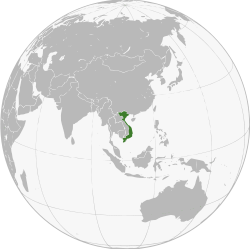
South Vietnam, officially the Republic of Vietnam, was a country in Southeast Asia that existed from 1955 to 1975, the period when the southern portion of Vietnam was a member of the Western Bloc during part of the Cold War after the 1954 division of Vietnam. It first received international recognition in 1949 as the State of Vietnam within the French Union, with its capital at Saigon, before becoming a republic in 1955. South Vietnam was bordered by North Vietnam to the north, Laos to the northwest, Cambodia to the southwest, and Thailand across the Gulf of Thailand to the southwest. Its sovereignty was recognized by the United States and 87 other nations, though it failed to gain admission into the United Nations as a result of a Soviet veto in 1957. It was succeeded by the Republic of South Vietnam in 1975. In 1976, the Republic of South Vietnam and North Vietnam merged to form the Socialist Republic of Vietnam.
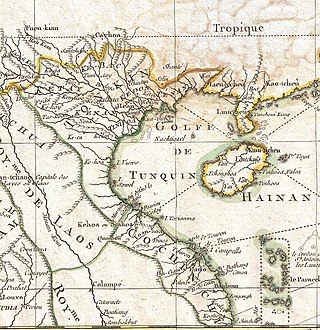
Tonkin, also spelled Tongkin, Tonquin or Tongking, is an exonym referring to the northern region of Vietnam. During the 17th and 18th centuries, this term referred to the domain Đàng Ngoài under Trịnh lords' control, including both the Northern and Thanh-Nghệ regions, north of the Gianh River. From 1884 to early 1945, this term was used for the French protectorate of Tonkin, composed of only the Northern region.

Annam, or Trung Kỳ (中圻), was a French protectorate encompassing the territory of the Empire of Đại Nam in Central Vietnam. Before the protectorate's establishment, the name Annam was used in the West to refer to Vietnam as a whole; Vietnamese people were referred to as Annamites. The protectorate of Annam became a part of French Indochina in 1887, along with two other Vietnamese regions, Cochinchina in the South and Tonkin in the North. The region had a dual system of French and Vietnamese administration. The government of the Nguyễn Dynasty still nominally ruled Annam and Tonkin as the Empire of Đại Nam, with the emperor residing in Huế. In 1948, the protectorate was merged in the Provisional Central Government of Vietnam, which was replaced the next year by the newly established State of Vietnam. The French legally maintained the protectorate until they formally signed over sovereignty to the Bảo Đại and the government of the State of Vietnam in 1950 after signing the Élysée Accords in 1949. The region was divided between communist North Vietnam and anti-communist South Vietnam under the terms of the Geneva Accord of 1954.
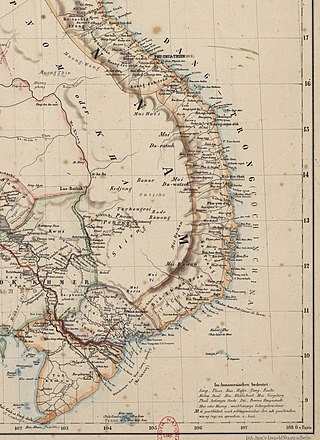
Cochinchina or Cochin-China is a historical exonym for part of Vietnam, depending on the contexts. Sometimes it referred to the whole of Vietnam, but it was commonly used to refer to the region south of the Gianh River.

The national flag of Vietnam, formally the National Flag of the Socialist Republic of Vietnam, locally recognized as cờ đỏ sao vàng or cờ Tổ quốc, was designed in 1940 and used during an uprising against the French in southern Vietnam that year. The red background symbolizes revolution and bloodshed. The golden star represents the five main classes in Vietnamese society—intellectuals, farmers, workers, entrepreneurs, and soldiers.

Empress Nam Phương, born Marie-Thérèse Nguyễn Hữu Thị Lan, was the last empress consort of Vietnam. She was the wife of Bảo Đại, the last emperor of Vietnam, from 1934 until her death. She was also the second and last empress consort of the Nguyễn dynasty.

The State of Vietnam was a governmental entity in Southeast Asia that existed from 1949 until 1955, first as a member of the French Union and later as a country. The state claimed authority over all of Vietnam during the First Indochina War, although large parts of its territory were controlled by the Democratic Republic of Vietnam.

French Cochinchina was a colony of French Indochina, encompassing the whole region of Lower Cochinchina or Southern Vietnam from 1862 to 1946. The French operated a plantation economy whose primary strategic product was rubber.

The Empire of Vietnam was a short-lived puppet state of Imperial Japan governing the former French protectorates of Annam and Tonkin between March 11 and August 25, 1945. At the end of its rule, the empire also successfully reclaimed Cochinchina as part of Vietnam.

Trần Văn Hữu served as president of the government of Cochinchina from 1948 to 1949, then as Prime Minister of the State of Vietnam from 1950 to 1952.
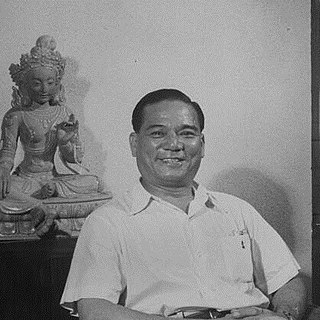
Lê Văn Hoạch was a Vietnamese doctor and politician who served as prime minister of Cochinchina from 1946 to 1947.
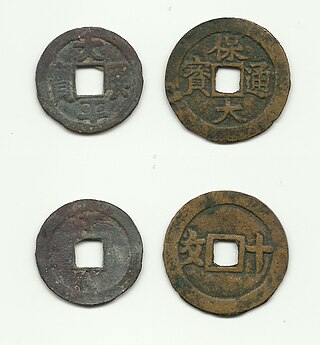
The Vietnamese cash, also called the sapek or sapèque, is a cast round coin with a square hole that was an official currency of Vietnam from the Đinh dynasty in 970 until the Nguyễn dynasty in 1945, and remained in circulation in North Vietnam until 1948. The same type of currency circulated in China, Japan, Korea, and Ryūkyū for centuries. Though the majority of Vietnamese cash coins throughout history were copper coins, lead, iron and zinc coins also circulated alongside them often at fluctuating rates. Coins made from metals of lower intrinsic value were introduced because of various superstitions involving Vietnamese people burying cash coins, as the problem of people burying cash coins became too much for the government. Almost all coins issued by government mints tended to be buried mere months after they had entered circulation. The Vietnamese government began issuing coins made from an alloy of zinc, lead, and tin. As these cash coins tended to be very fragile, they would decompose faster if buried, which caused the Vietnamese people to stop burying their coins.
Đinh Xuân Quảng was a Vietnamese judge and a politician who helped institute a new constitution for South Vietnam. Đinh Xuân Quảng was one of the main advocates of the “Nationalist solution” in the efforts to regain independence from France after World War II – an independence which could ultimately be settled through negotiations and peaceful means. He participated throughout this resolution process and negotiated various agreements with France. His efforts led to the abrogation of the Patenotre Treaty in 1884 which had placed Vietnam under a protectorate of France.
The following is a list of political organizations and armed forces in Vietnam, since 1912:

The 11th Central Committee of the Communist Party of Vietnam was elected at the 11th National Congress of the Communist Party of Vietnam. The 11th Central Committee elected the 11th Politburo and the 11th Secretariat.

The House of Nguyễn Phúc, also known as the House of Nguyễn Phước, was a ruling family of Vietnam. It ruled from the city of Huế in central Vietnam beginning in 1636. As the Nguyễn lords, they often fought with the Trịnh lords, who were based in Hanoi. They were overthrown by the Tây Sơn dynasty in 1776.

Tonkin, or Bắc Kỳ, was a French protectorate encompassing modern Northern Vietnam. Like the French protectorate of Annam, Tonkin was still nominally ruled by the Nguyễn dynasty, but in 1886, the French separated Tonkin from the Nguyễn imperial court in Huế by establishing the office of "Viceroy". However, on 26 July 1897, the position of Viceroy was abolished, officially making the French resident-superior of Tonkin both the representative of the French colonial administration and the Nguyễn dynasty court in Huế, giving him the power to appoint local mandarins. In 1887, Tonkin became a part of the Union of Indochina.

The Khải Định Thông Bảo was a French Indochinese sapèque coin produced from 1921 until 1933, the design of the coin was round with a square hole that was used for stringing them together. Khải Định became Emperor of Annam in 1916 the funding for the production of new cash coins was reduced by the Hanoi Mint which lead to the demand of the Vietnamese market for low value denominations to not be met, furthermore, after Hanoi reduced funding for the Thanh Hóa Mint, which until that time was producing enough low denomination cast cash coins to meet the market's demands, which caused most, but not all, of the production of cash coins at the mint to cease in 1920. In response a new committee was formed in Hanoi which ordered the creation of machine-struck Khải Định Thông Bảo cash coins, these are the first machine-struck four character Thông Bảo (通寳) coins in Vietnam with the reigning emperor's name as the French government had prior tried to introduce a Cochinchinese 2 sapèque coin that continued under French Indochina that weighed 2.05 grams and had a nominal value of 1⁄500 piastre, later the colonial government of the French Protectorate of Tonkin had unsuccessfully tried to introduce a zinc milled sapèque produced by the Paris Mint with a nominal value of 1⁄600 piastre from 1905 until 1906. Unlike the earlier attempts at producing machine-struck cash coins by the colonial French authorities the Khải Định Thông Bảo proved to be much more successful as the first series had a production of 27,629,000 coins while the second series greatly exceeded this with around 200,000,000 coins produced in Huế, Haiphong, and Hanoi. The Khải Định Thông Bảo continued to be produced long after the death of Emperor Khải Định under his successor Bảo Đại until it was phased out by the Bảo Đại Thông Bảo (保大通寳) in 1933.

The government of the Nguyễn dynasty, officially the Southern dynasty and commonly referred to as the Huế Court, centred around the emperor as the absolute monarch, surrounded by various imperial agencies and ministries which stayed under the emperor's presidency. Following the signing of the Patenôtre Treaty the French took over a lot of control and while the government of the Nguyễn dynasty still nominally ruled the French protectorates of Annam and Tonkin, in reality the French maintained control over these territories and the Nguyễn government became subsidiary to the administration of French Indochina. During World War II the Japanese launched a coup d'état ousting the French and establishing the Empire of Vietnam which was ruled by the Nguyễn government. During the August Revolution the Nguyễn government was abolished in the aftermath of World War II.

During the Nguyễn dynasty period (1802–1945) of Vietnamese history its Ministry of Education was reformed a number of times, in its first iteration it was called the Học Bộ, which was established during the reign of the Duy Tân Emperor (1907–1916) and took over a number of functions of the Lễ Bộ, one of the Lục Bộ. The Governor-General of French Indochina wished to introduce more education reforms, the Nguyễn court in Huế sent Cao Xuân Dục and Huỳnh Côn, the Thượng thư of the Hộ Bộ, to French Cochinchina to discuss these reforms with the French authorities. After their return the Học Bộ was established in the year Duy Tân 1 (1907) with Cao Xuân Dục being appointed to be its first Thượng thư (minister). Despite nominally being a Nguyễn dynasty institution, actual control over the ministry fell in the hands of the French Council for the Improvement of Indigenous Education in Annam.
